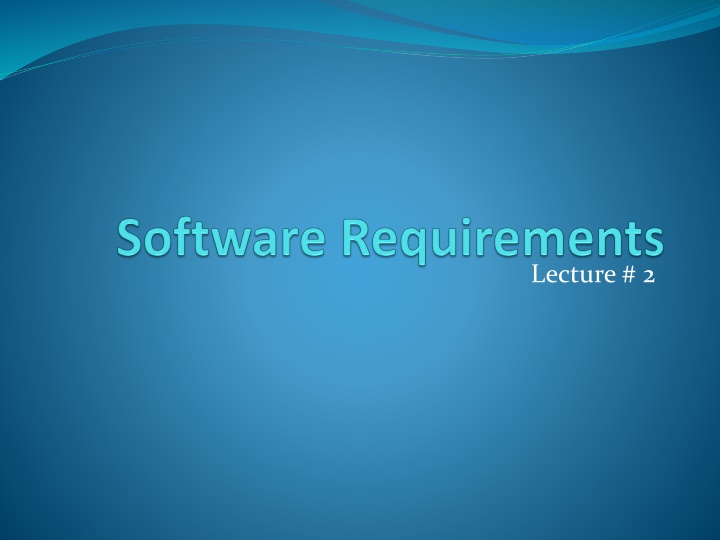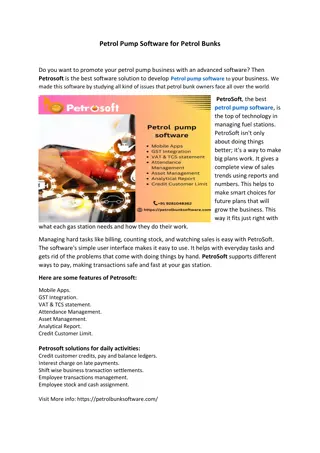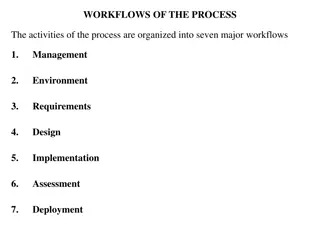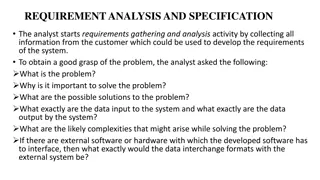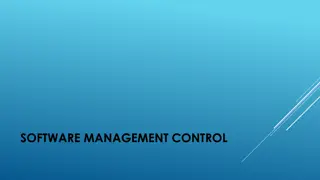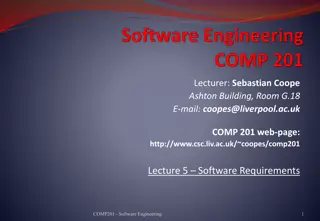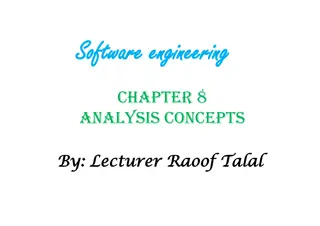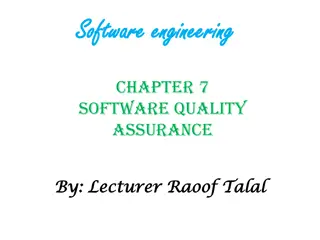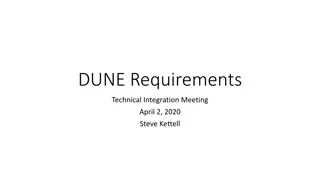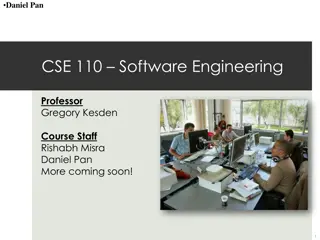Overview of Software Requirements
Software requirements are classified into functional and non-functional categories, with non-functional requirements playing a crucial role in the overall system performance and usability. Non-functional requirements encompass aspects like timing, performance, reliability, security, and more, ensuring the system's effectiveness and user satisfaction.
Download Presentation

Please find below an Image/Link to download the presentation.
The content on the website is provided AS IS for your information and personal use only. It may not be sold, licensed, or shared on other websites without obtaining consent from the author.If you encounter any issues during the download, it is possible that the publisher has removed the file from their server.
You are allowed to download the files provided on this website for personal or commercial use, subject to the condition that they are used lawfully. All files are the property of their respective owners.
The content on the website is provided AS IS for your information and personal use only. It may not be sold, licensed, or shared on other websites without obtaining consent from the author.
E N D
Presentation Transcript
Kinds of Software Requirements Functional requirements Non-functional requirements Domain requirements Inverse requirements Design and implementation constraints 2
Non-Functional Requirements - 1 Most non-functional requirements relate to the system as a whole. They include constraints on timing, performance, reliability, security, maintainability, accuracy, the development process, standards, etc. 4
Non-Functional Requirements - 2 They are often more critical than individual functional requirements Capture the emergent behavior of the system, that is they relate to system as a whole 5
Non-Functional Requirements - 3 Must be built into the framework of the software product Failure to meet a non-functional system requirement may make the whole system unusable 6
Non-Functional Requirements - 4 For example, if an aircraft system does not meet reliability requirements, it will not be certified as safe If a real-time control system fails to meet its performance requirements, the control functions will not operate correctly 7
Non-Functional Requirements Non-Functional requirements Product requirements Organizational requirements External requirements 8
Product Requirements Product requirements Efficiency requirements Usability requirements Reliability requirements Portability requirements Performance requirements Space requirements 9
Product Requirements Examples The system shall allow one hundred thousand hits per minute on the website The system shall not have down time of more than one second for continuous execution of one thousand hours 10
Organizational Requirements Organizational requirements Standards requirements Implementation requirements Delivery requirements 11
Organizational Requirements Examples The system development process and deliverable documents shall conform to the MIL-STD-2167A Any development work sub-contracted by the development organization shall be carried out in accordance with Capability Maturity Model 12
External Requirements External requirements Interoperability requirements Ethical requirements Legislative requirements Privacy requirements Safety requirements 13
External Requirements Examples The system shall not disclose any personal information about members of the library system to other members except system administrators The system shall comply with the local and national laws regarding the use of software tools 14
Summary Discussed different aspects of the non- functional requirements Non-functional requirements capture very important emergent behavior of the automated system Due importance, time, and resources should be given to non-functional requirements 15
References Requirements Engineering: Processes and Techniques by G. Kotonya and I. Sommerville, John Wiley & Sons, 1998 Software Requirements: Objects, Functions, and States by A. Davis, PH, 1993 Software Engineering 6th Edition, by I. Sommerville, 2000 Software Engineering 5th Edition, by R. Pressman 16
Kinds of Software Requirements Functional requirements Non-functional requirements Domain requirements Inverse requirements Design and implementation constraints 17
Non-Functional Requirements Discussion NFRs are very important to capture the emergent behavior of the system in these there major dimensions Product Usability, reliability, portability, efficiency (performance, space) Organizational Standards, implementation, delivery External Interoperability, ethical, legislative (privacy, safety) 18
NFRs as Goals Non-functional requirements are sometimes written as general goals, which are difficult to verify They should be expressed quantitatively using metrics (measures) that can be objectively tested 19
Example: Goal converted into an NFR Goal (unverifiable) The system should be easy to use by experienced controllers and should be organized in such a way that user errors are minimized Non-functional requirement (verifiable) Experienced controllers shall be able to use all the system functions after a total of two hours training. After this training, the average number of errors made by experienced users shall not exceed two per day 20
Metrics for NFRs - 1 Property Measure 1. Processed transactions/second Response time Screen refresh time Speed 2. 3. Requirements related to Speed can use different measures to quantify the goal 22
Metrics for NFRs - 2 Property Measure 1. 2. K bytes Number of function points Size 23
Metrics for NFRs - 3 Property Measure 1. 2. Training time Number of help frames Ease of use 24
Metrics for NFRs - 4 Property Measure 1. 2. Mean time to failure Probability of unavailability Rate of failure occurrence Availability Reliability 3. 4. 25
Metrics for NFRs - 5 Property Measure 1. Time to restart after failure Percentage of events causing failure Probability of data corruption on failure Robustness 2. 3. 26
Metrics for NFRs - 6 Property Measure 1. Percentage of target- dependent statements Number of target systems Portability 2. 27
Discussion on Metrics for NFRs With the help of these measures the NFRs can be verified quantitatively It should also be noted that the cost of quantitatively verifying each NFR may be very high 28
Kinds of Software Requirements Functional requirements Non-functional requirements Domain requirements Inverse requirements Design and implementation constraints 29
Domain Requirements - 1 Requirements that come from the application domain and reflect fundamental characteristics of that application domain These can be both the functional or non-functional requirements 31
Domain Requirements - 2 These requirements, sometimes, are not explicitly mentioned Domain experts find it difficult to convey domain requirements Their absence can cause significant dissatisfaction 32
Domain Requirements 3 Example: In a commission-based sales businesses, there is no concept of negative commission. However, if care is not taken novice developers can be lured into developing systems, which calculate negative commission 33
Domain Requirements - 4 Banking domain has its own specific constraints, for example, most banks do not allow over-draw on most accounts, however, most banks allow some accounts to be over-drawn 34
Kinds of Software Requirements Functional requirements Non-functional requirements Domain requirements Inverse requirements Design and implementation constraints 35
Inverse Requirements - 1 They explain what the system shall not do. Many people find it convenient to describe their needs in this manner These requirements indicate the indecisive nature of customers about certain aspects of a new software product 37
Inverse Requirements - 2 Example: The system shall not use red color in the user interface, whenever it is asking for inputs from the end-user 38
Kinds of Software Requirements Functional requirements Non-functional requirements Domain requirements Inverse requirements Design and implementation constraints 39
Design and Implementation Constraints - 1 They are development guidelines within which the designer must work These requirements can seriously limit design and implementation options Can also have impact on human resources 40
Design and Implementation Constraints Examples The system shall be developed using the Microsoft .Net platform The system shall be developed using open source tools and shall run on Linux operating system 41
Summary Discussed different kinds of requirements including domain, inverse, and implementation constraints Requirements should be explored from different perspectives and categorized differently 42
References Requirements Engineering: Processes and Techniques by G. Kotonya and I. Sommerville, John Wiley & Sons, 1998 Software Requirements: Objects, Functions, and States by A. Davis, PH, 1993 Software Engineering 6th Edition, by I. Sommerville, 2000 Software Engineering 5th Edition, by R. Pressman 43
